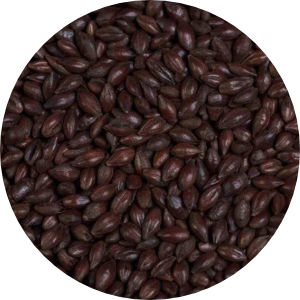Black (Patent) Malt
| Type: | Grain |
|---|---|
| Species: | Barley |
| Category | Roasted Malt |
Description

Black malt (sometimes called black patent malt) is made from fully-modified pale malt, containing around 5% moisture that adds an acird or bitterness to your brew. Black malt primarily gives a highly roasted flavor, that carries some bitterness and acidity. Like all dark grains, black malt is an acidic malt. A mash of black malt only would yield a pH value under 4. In beers that use a substantial amount of it, adding carbonates - either from calcium carbonate (chalk) or sodium bicarbonate (baking soda) to your water may be needed to keep the mash in the proper range.
Just one ounce of black patent malt (28 g) in 5 gallons (19 L) of pale beer adds 5–6 SRM color.
Black malt is made from fully-modified pale malt, containing around 5% moisture. The malt is then placed in a roasting drum and rehydrated and kilned at 221–233 °C (420–450 °F) for up to four hours. Black malt actually has a 6% moisture content that is higher than most other specialty grains. The moisture content gives the malt some added stability while it quickly cools the malt.
Unlike pale malts, black patent malt is nearly sterile. Some commercial breweries, in fact, use black malt (or black malt flour) in their fermentors rather than the mash tun.
Beer Styles Using: Stouts, Porters, Red Ales, Brown Ales, Porters, Scotch Ales, Dark Lagers
Commercial Examples: Muntons Black Malt, Briess Black Malt
Black (Patent) Malt Brewing Values
These are the common ranges that we've seen with Black (Patent) Malt over the years. Each manufacturer can have slightly different qualities, so these ranges are based on a combination and average.
| SRM SRM is a scale for measuring the color intensity of a beer. Low SRM values indicate a pale straw color while higher values mean the style should have a darker color. Learn more » |
–
400-500 SRM(297 - 371° Lovibond) |
|---|---|
| Diastatic Power Diastatic power (DP) is a measurement of a malted grain's enzymes, which are responsible for converting the grain's starches into sugar during mashing. |
|
| PPG PPG measures the maximum starting gravity (SG) of the fermentable in points/pound/gallon. This can differ based on your mash efficiency and the amount of wort collected. |
26.5 ppg (1.027 SG) |
| Batch Max Certain grains and adjuncts should only be used below a maximum percentage of the grain bill. Exceeding this can cause off flavors or poor mash efficiency. |
10% |
If you see an error in our data, please let us know!
We are not affiliated with any grain manufacturer. All copyrights and data are provided by their respective owners.